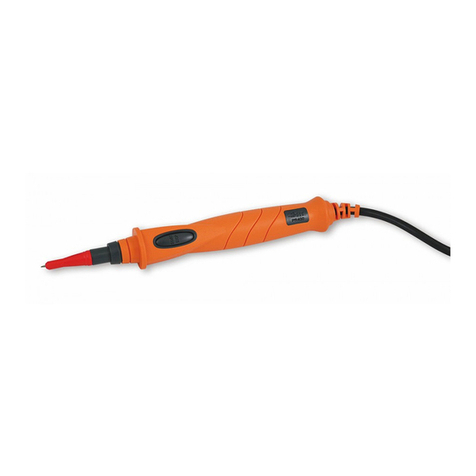1.0 Allgemeine Informationen
Achtung Verletzungsgefahr! Die Messspitzen sind scharf.
• Tragen Sie das Gerät niemals ohne Schutzkappe am Gürtel.
• Lesen Sie diese Anleitung sorgfältig, um einen sicheren Umgang mit dem Gerät zu gewähr-
leisten. Bewahren Sie die Anleitung mit dem Gerät auf.
• Kontrollieren Sie das Gerät vor jedem Gebrauch auf einwandfreien Zustand.
Sollten Sie Zweifel haben, kontaktieren Sie bitte einen Fachmann oder den Hersteller.
• Benutzen Sie niemals ein fehlerhaftes Gerät.
• Im Falle von Beschädigungen lassen Sie das Gerät nur von autorisiertem Fachpersonal
und nur mit Originalteilen reparieren. Damit erhalten Sie die Garantieansprüche und die
Sicherheit des Messgerätes.
• Legen Sie niemals elektrische Spannung an das Gerät an, da dies zur Beschädigung des
Gerätes führen kann.
•In Umgebungen mit explosiven oder entflammbaren Gasen darf das Gerät nicht benutzt
werden.
• Gehen Sie sorgsam mit dem Messgerät um. Vermeiden Sie harte Stöße oder Schläge. Las-
sen Sie das Gerät nicht fallen.
• Zerlegen Sie das Gerät nicht.
•Bewahren Sie das Gerät an einem sauberen und trockenen Ort auf.
• Bringen Sie das Gerät nicht in Kontakt mit Wasser, Schmutz und Staub.
• Zur Reinigung des Gerätes benutzen Sie ein trockenes oder leicht feuchtes Tuch und nur
milde Reinigungsmittel, keinesfalls Scheuer- oder Lösungsmittel.
• Schauen Sie nicht in das LED-Licht, es kann Ihre Augen blenden und schädigen.
• Dieses Gerät ist nicht dafür bestimmt, von Personen mit eingeschränkten physischen,
sensorischen oder geistigen Fähigkeiten und/oder ohne Fachkenntnis
benutzt zu werden. Das Gerät gehört nicht in Kinderhände.
2.0 Sorgfältiger Umgang und Gebrauch von Batterien
•Bei falscher Anwendung kann Batterieflüssigkeit aus der Batterie austreten. Vermeiden
Sie den Kontakt. Bei zufälligem Hautkontakt mit Wasser abspülen. Wenn austretende Flüssig-
keit in die Augen kommt, nehmen Sie zusätzlich ärztliche Hilfe in Anspruch. Austretende Bat-
terieflüssigkeit kann zu Hautreizungen und Verbrennungen führen.
• Nicht mit dem Hausmüll entsorgen. Zur Wiederverwertung oder umweltverträglichen Ent-
sorgung, geben Sie Batterien nur bei einer Wertstoffsammelstelle ab.
• Batterien nicht ins Feuer werfen, Explosionsgefahr.
• vor Hitze (z. B. Heizung) oder Sonneneinstrahlung schützen.
• niemals wieder aufladen! Explosionsgefahr!
• von Kindern fernhalten! Sofort einen Arzt aufsuchen, wenn eine Batterie verschluckt wurde.
• nicht ins Feuer werfen, kurzschließen oder auseinander nehmen.
• Batterie- und Gerätekontakte vor dem Einlegen bei Bedarf reinigen.
• Nur Batterien des gleichen Typs einsetzen, keine unterschiedlichen Typen oder
gebrauchte und neue Batterien miteinander verwenden.
OEG Feuchtemessgerät D3































